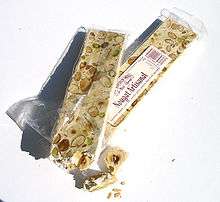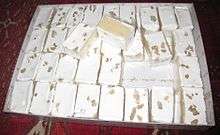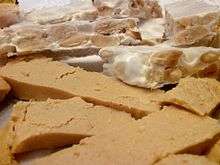Nougat
Nougat (US: /ˈnuːɡət/ NOO-gət, UK: /ˈnuːɡɑː/ NOO-gah;[1][2][3][4] French: [nuɡa]; Azerbaijani: nuga; Persian: نوقا) is a family of confections made with sugar or honey, roasted nuts (almonds, walnuts, pistachios, hazelnuts, and macadamia nuts are common), whipped egg whites, and sometimes chopped candied fruit. The consistency of nougat is chewy, and it is used in a variety of candy bars and chocolates. The word nougat comes from Occitan pan nogat (pronounced [ˈpa nuˈɣat]), seemingly from Latin panis nucatus 'nut bread' (the late colloquial Latin adjective nucatum means 'nutted' or 'nutty').
 Nougat bar | |
| Type | Confection |
|---|---|
| Main ingredients | White nougat: sugar or honey, nuts (almonds, walnuts, pistachios, hazelnuts), egg whites, sometimes candied fruit Brown nougat: sugar or honey, nuts (almonds, walnuts, pistachios, hazelnuts) Viennese or German nougat: sugar, nuts, chocolate |
| Variations | Gaz (candy), torrone and turrón |
| 200 kcal (837 kJ) | |
There are three basic kinds of nougat. The first, and most common, is white nougat (mandorlato or torrone in Italy, turrón in Spain), made with beaten egg whites and honey; it appeared in the early 15th century, in Alicante, Spain with the first published recipe in the 16th century,[5] and in Montélimar, France, in the 18th century. The second is brown nougat (nougat noir in French, literally 'black nougat'; in Italian croccante, meaning 'crunchy'), which is made without egg whites and has a firmer, often crunchy texture. The third is the Viennese or German nougat which is essentially a chocolate and nut (usually hazelnut) praline.
History
Many legends exist around nougat’s origins. Early recipes of white nougat, probably borrowed from Central Asia, were found in a Middle Eastern book in Baghdad the 10th century. That nougat was called ناطف nāṭif.[6] One of these recipes indicates that the nāṭif comes from Harran, a city located between Urfa (now in southeast Turkey) and Aleppo, Syria. Mention of nāṭif was found in a triangle between Urfa, Aleppo, and Baghdad. At the end of the 10th century, the traveler and geographer Ibn Hawqal wrote that he ate some nāṭif in Manbij (in modern Syria) and Bukhara (in modern Uzbekistan).[7]
Distribution and popularity
In southern Europe, nougat is a prominent component of Christmas meals.[8]

Turrón is produced in Spain, Nougat in southern France, torrone, mandorlato or even cupeta and cubbaita – from Latin cupedia in Cremona, Taurianova and Sicily in Italy,[9] in Greece where it is known as mandolato or mandola, Malta (where it is known as qubbajd and sold in village festivals), Romania (where it is known as alviță sold in local festivals and fairgrounds, mainly on the Sunday of Forgiveness preceding the Easter Lent), and in local variant form in Tabriz, Iran where it is known as Luka.
The nougat that appears in many candy bars in the United States and United Kingdom differs from traditional recipes, consisting of sucrose and corn syrup aerated with a whipping agent such as egg white, hydrolyzed soya protein or gelatine and may include vegetable fats and milk powder. Typically it is combined with nuts, caramel, or chocolate. Some American confections feature this type of nougat as the primary component, rather than combined with other elements. Varieties of nougat are found in Milky Way, Reese's Fast Break, Snickers,[10] Double Decker, ZERO bars, and Baby Ruth bars. Whipped nougat is the featured ingredient in the 3 Musketeers bar.[11][12]
In Britain, nougat is traditionally made in the style of the southern European varieties, and is commonly found at fairgrounds and seaside resorts. The most common industrially produced type[13] is coloured pink and white, the pink often fruit flavoured, and sometimes wrapped in edible rice paper with almonds and cherries.
After nougat spread to Taiwan, it began to add milk powder as the main raw material, plus sugar, cream, protein (some companies will use whey protein refined from fresh milk instead of protein and protein powder), nuts (such as peanuts , Almonds, walnuts, pistachios or hazelnuts), dried fruit and petals (such as cranberry, golden pomelo, mango, orange, longan, osmanthus, etc.) as a secondary raw material, becoming Taiwanese nougat Unique features. Compared to table-top nougat, French European nougat does not have any milk or milk powder ingredients. It is purely made by adding sugar or honey to egg whites and sprinkling almonds or nuts. In addition, some manufacturers use edible rice paper to prevent the nougat from being deformed, but how much will affect the taste, so the choices vary from person to person.
Variations


Spanish turrón follows the traditional recipes with toasted nuts (commonly almonds), sugar, honey, and egg whites.[14]
Torrone from Italy includes these same basic ingredients as well as vanilla or citrus flavoring, and is often sandwiched between two very thin sheets of rice paper.[15] The Venetian town of Cologna Veneta is well known for its nougat production, especially the type called mandorlato, always based on honey, sugar, egg whites, and almonds (also known as mandorle in Italian) but with a different taste and harder to bite than torrone.
"Wiener (Viennese) Nougat" is a variant which contains only sugar, cocoa butter, nuts, and cocoa mass, and has a mellow consistency. The nuts used for Viennese nougat are usually hazelnuts. In Germany and the Nordic countries, Viennese nougat is what has traditionally been associated with and labelled as nougat,[16][17] while in Sweden and Denmark the original nougat is referred to as "French nougat".[18][19] In Germany, gianduja is traditionally called nougat.
See also
References
- "nougat". OxfordDictionaries.com. Oxford University Press. Retrieved 30 June 2016.
- "nougat". Cambridge Dictionary Online. Cambridge University Press. Retrieved 19 August 2013.
- "nougat". Dictionary.com. Retrieved 19 August 2013.
- "nougat". TheFreeDictionary.com. Retrieved 19 August 2013.
- Anonymous (2000) [c. 1550]. Majada Neila, Jesús (ed.). Manual de mujeres en el cual se contienen muchas y diversas recetas muy buenas (in Spanish). Caligrama. ISBN 9788493176341. Retrieved 2 November 2016 – via Biblioteca Virtual Miguel de Cervantes.
- Derived from the triliteral root nṭf 'to dribble, to trickle', literally denoting a white viscous mass, as in ناطف الحوت nāṭif al-ḥūt, 'spermaceti'. Source: "ترجمة ومعنى كلمة ناطف" [Translation and meaning of the word nāṭif]. Almaany.com (in Arabic). Retrieved 26 June 2016.
- Moncorgé, Marie Josèphe (2018). "All kinds of nougat, A journey through the Mediterranean history of a confectionery". TAMBAO. Retrieved 8 April 2019.
- Jessop, Tara. "A Brief History Of Spanish Turrón". Culture Trip. Retrieved 2017-10-25.
- "Torrone di Benevento". sito.regione.campania.it (in Italian). Archived from the original on 3 March 2016. Retrieved 12 February 2016.
- "15 of Your Favorite Famous Halloween Treats, Made Vegan! | One Green Planet". www.onegreenplanet.org. Retrieved 2017-10-27.
- Randal, Oulton (2006-01-12). "Three Musketeers Bars". CooksInfo.com.
- "The History of the 3 Musketeers Candy Bar | LEAFtv". LEAFtv. Retrieved 2017-10-27.
- "Barrat Nougat Bar Sweets product reviews and price comparison". DooYoo.co.uk. Archived from the original on 23 December 2012. Retrieved 12 February 2016.
- "nougat | confection". Encyclopedia Britannica. Retrieved 2017-10-25.
- Gangi, Roberta (2005). "Sicilian Torrone". Best of Sicily Magazine. Retrieved 7 May 2008.
- Odense: Nougat - ingredients (in Danish)
- Odense: Blød Nougat Archived 2014-12-30[Date mismatch] at the Wayback Machine Pictures and description. (in Danish)
- "Fransk Nougat". Marabou.se (in Swedish). Marabou. 17 December 2010. Retrieved 31 August 2014.
- Marabou. "Fransk Nougat". nemlig.com (in Danish). Retrieved 31 August 2014.